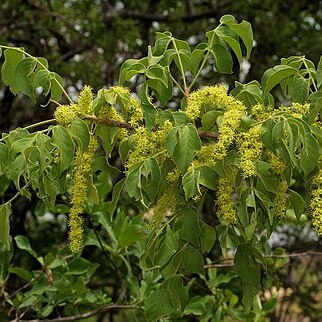Shrub or tree 3–15(–22) m. high, irregularly branched; crown spreading or rounded with drooping branchlets; bark grey or brown, reticulate, flaking off in fragments up to 10 cm. long.. Leaves clustered at the apices of the branchlets, 3–9(–13)-foliolate or rarely unifoliolate; rachis 5–22 cm. long, semicylindric, longitudinally grooved above, glabrous or with a few stellate and simple hairs; leaflets subcoriaceous, glabrous or with stiff white hairs nearly always present in the axils of the lower nerves or with minute scattered hairs especially on the nerves below or (outside Flora area) pubescent on both surfaces; terminal leaflet elliptic to broadly elliptic, ovate or reniform, 2–9 cm. long, 1.7–6 cm. broad, symmetric at the base and with a petiolule 7–25 mm. long; lateral leaflets 3–11 cm. long, 2–5.3 cm. broad, asymmetric at the base, subsessile or with petiolule 1–5 mm. long; all leaflets caudate, bluntly acuminate or even obtuse at the apex, margin entire; midrib impressed above, prominent beneath; lateral nerves 4–8 pairs; reticulation impressed beneath.. Inflorescences spike-like racemes or little branched panicles 2–20(–40) cm. long, arising with the leaves, subglabrous or thinly pubescent; flowers in scattered fascicles; pedicels 0.5–4 mm. long, with few stellate hairs.. Calyx-lobes semicircular, 1–1.5 mm. long, ciliate-denticulate, glabrous or stellate-hairy.. Petals oblong-ovate, concave, 3–4.5 mm. long, 1.2–2.5 mm. broad, greenish yellow to yellow.. Drupe oblong-ellipsoid and compressed, 8–12 mm. long, 6–8 mm. broad on the long diameter, red or brown, edible.
More
A shrub or small deciduous tree. It can grow up to 12 m tall. The trunk can be 30 cm across. Often it is smaller and spreading and drooping. It usually grows 3-5 m tall. The branches are irregular and grey. The crown is rounded and the tips of the small branches droop. The bark is dark grey and fairly smooth but flakes off when older. The bark flakes off in rectangular pieces showing creamy-orange colour below. The leaves are large, shiny and compound. They are produced on long stalks on small branches. The leaves consist of 1-4 pairs of opposite leaflets and a leaflet at the end. They are oval to round and bluntly pointed. The side leaflets are somewhat lopsided. The leaflets are 4-6 cm long by 1.3-4 cm wide. They turn bright yellow in autumn. The leaf stalk is grooved. The flowers are small and cream in colour. They hang in spikes up to 20 cm long. They have a strong scent. Trees are separately male and female. The fruit are oval and slightly flattened. They are 0.8-2.5 cm long. They have 3 small knobs at the top. The fruit are green but turn purple. The skin easily comes off revealing orange slimy flesh. They are edible.
A tropical plant. It grows in the lowlands. It is common in wooded grassland in Africa. In Uganda it grows between 700 and 1,600 m altitude. It may be extinct in Swaziland. It is frost sensitive. It often grows on flat sandy, or gravely soil. It can grow in arid places.
More
In river valleys forests, woodlands of several types (including coastal), savannahs, on termite mounds, etc. Lowland dry forests. Woodlands and grasslands at elevations up to 1,820 metres.

